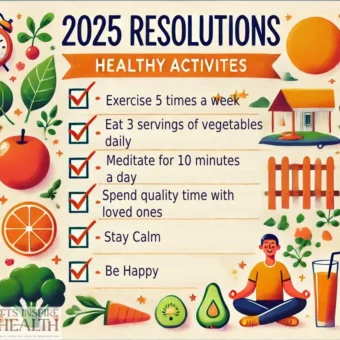In today’s fast-paced world, achieving a balanced state of well-being is more essential than ever. A balanced life helps us cultivate both mental clarity and physical vitality, enabling us to navigate life’s demands with resilience and grace. Yet, holistic health isn’t just about checking off boxes for diet and exercise; it’s about nurturing a symbiotic relationship between our mental and physical well-being. When we honor both dimensions of health, we unlock a deeper sense of peace, fulfillment, and energy that allows us to thrive in all areas of life.
This journey toward balance is not a one-size-fits-all approach. It’s a continuous, intentional practice of aligning our thoughts, actions, and lifestyle with what nourishes both our mind and body. In this article, we’ll explore practical strategies and mindful practices that promote a harmonious relationship between mental and physical health. Let this guide be your companion in discovering how to achieve holistic balance, nurturing a life of wellness, resilience, and inner peace.
Table of Contents
- Understanding Holistic Health
- The Interconnectedness of Mind and Body
- Mental Health and Its Influence on Physical Well-Being
- Physical Health as a Foundation for Mental Clarity
- Strategies for Achieving Holistic Balance
- Practice Mindful Movement
- Cultivate a Nourishing Diet
- Prioritize Quality Sleep
- Engage in Mental Detox Practices
- Connect with Nature
- Nurture Social Connections
- Creating a Personalized Holistic Wellness Routine
- Overcoming Challenges in Maintaining Holistic Balance
Final Reflections: Embarking on Your Journey to Balanced Well-Being
1. Understanding Holistic Health
Holistic health encompasses more than just the absence of illness. It’s a philosophy that views health as an integration of body, mind, and spirit. This approach recognizes that our mental and physical states are deeply interconnected and that true wellness arises when we address the whole person. Holistic health is about honoring this unity, understanding that every choice we make—from the foods we consume to the thoughts we hold—affects our overall well-being.
Achieving holistic balance requires us to recognize our unique needs and preferences. It calls for a harmonious blend of practices that support our mental clarity, emotional resilience, and physical strength. This mindset empowers us to make choices that align with our values and support a balanced, vibrant life.
2. The Interconnectedness of Mind and Body
The mind and body are in constant communication, influencing each other in complex and profound ways. This relationship means that our mental state can affect our physical health, just as our physical condition can impact our mental outlook. When we experience stress or anxiety, our body responds with physiological changes, such as an elevated heart rate or muscle tension. Similarly, when we engage in physical activity or nourish ourselves with nutritious foods, we often feel a boost in mood and mental clarity.
Understanding this connection allows us to make intentional choices that nurture both mind and body. By recognizing that mental and physical health are interwoven, we can adopt practices that bring balance and coherence to our lives, fostering a harmonious state of well-being.
3. Mental Health and Its Influence on Physical Well-Being
Mental health significantly impacts our physical health. Chronic stress, anxiety, and depression can contribute to a range of physical symptoms, from digestive issues to weakened immune function. Conversely, when our mental health is nurtured, we’re more likely to experience better physical resilience, fewer illnesses, and greater vitality.
The effects of mental health on the body illustrate the importance of addressing our emotional and psychological needs. By practicing self-care, seeking support when needed, and nurturing a positive mindset, we can positively influence our physical health and reduce the risk of stress-related illnesses.
4. Physical Health as a Foundation for Mental Clarity
Physical health is a crucial pillar of mental well-being. When our body is well-cared for, our mind is more focused, calm, and energized. Physical activity, quality sleep, and nutritious foods create the foundation for mental clarity and emotional stability.
For instance, exercise releases endorphins, the body’s natural mood elevators, helping us reduce stress and combat negative feelings. A balanced diet provides the nutrients our brain needs to function optimally, and quality sleep enables cognitive processes that support memory, decision-making, and emotional regulation.
5. Strategies for Achieving Holistic Balance
Here are some actionable strategies to help you foster a harmonious balance between mental and physical health. Each of these practices is designed to support both aspects of your well-being, creating a holistic foundation for wellness.
Practice Mindful Movement
Mindful movement, such as yoga, tai chi, or gentle stretching, combines physical activity with mindfulness, encouraging us to stay present and connected to our body. Unlike traditional exercise, mindful movement emphasizes intention and breath, fostering relaxation and reducing stress.
- How to Practice: Begin with a gentle routine that allows you to connect with your body’s movements. Focus on your breath and how your body feels, cultivating awareness rather than pushing limits.
- Benefits: Enhances flexibility, reduces stress, and fosters a sense of calm and awareness.
Cultivate a Nourishing Diet
Nutrition plays a fundamental role in both physical and mental health. A balanced diet rich in whole foods, fruits, vegetables, and healthy fats supports brain function, stabilizes mood, and provides lasting energy.
- How to Practice: Opt for nutrient-dense foods and try to minimize processed items. Aim for a diet rich in fiber, lean proteins, and antioxidant-rich fruits and vegetables.
- Benefits: Supports cognitive health, improves energy levels, and reduces inflammation.
Prioritize Quality Sleep
Sleep is essential for repairing the body and consolidating memories. When we rest well, we wake up with a clearer mind, greater resilience, and a stronger immune system.
- How to Practice: Establish a consistent bedtime routine, limit screen time before bed, and create a calming sleep environment.
- Benefits: Boosts mental clarity, strengthens the immune system, and enhances mood regulation.
Engage in Mental Detox Practices
Just as we cleanse our body, we can benefit from mental detoxing to clear our mind and alleviate stress. Journaling, meditation, and positive affirmations are effective ways to refresh our mindset and release negative thoughts.
- How to Practice: Set aside time each day for mental detox activities. This could include writing down worries, practicing mindfulness, or setting positive intentions.
- Benefits: Reduces stress, enhances mental clarity, and promotes emotional balance.
Connect with Nature
Spending time in nature is profoundly healing, helping us reconnect with our surroundings and find peace. Nature exposure lowers stress hormones and increases feelings of happiness and relaxation.
- How to Practice: Spend time outside each day, whether it’s a walk in the park, gardening, or simply sitting outdoors.
- Benefits: Lowers stress, boosts mood, and enhances physical health.
Nurture Social Connections
Our relationships have a significant impact on our mental and physical health. Meaningful connections provide support, reduce loneliness, and promote happiness.
- How to Practice: Reach out to loved ones regularly, engage in conversations, and invest time in nurturing relationships that bring positivity.
- Benefits: Strengthens emotional resilience, boosts mood, and provides a sense of belonging.
6. Creating a Personalized Holistic Wellness Routine
Building a routine tailored to your unique needs is key to achieving holistic balance. Here’s a simple example of a daily wellness routine that incorporates practices for both mental and physical health:
- Morning: Start with mindful breathing, followed by a nutritious breakfast.
- Midday: Engage in a short mindful movement session, such as stretching or a walk outside.
- Evening: Journal for mental clarity and practice gratitude before bed.
This routine can be adjusted based on your lifestyle, gradually integrating practices that resonate with you and support both mind and body.
7. Overcoming Challenges in Maintaining Holistic Balance
Staying balanced can sometimes be challenging, especially when life becomes overwhelming. Here are a few common obstacles and tips to overcome them:
- Time Constraints: Start with small changes that fit easily into your day.
- Lack of Motivation: Set achievable goals and celebrate progress to stay motivated.
- External Stressors: Develop a stress management plan and practice resilience-building techniques like gratitude and positive self-talk.
Overcoming these challenges requires patience and commitment, but each step toward balance contributes to a healthier, happier life.
8. Final Reflections: Embarking on Your Journey to Balanced Well-Being
Achieving holistic balance is a journey, not a destination. Each step we take toward nurturing our mental and physical health brings us closer to a state of harmony and fulfillment. By embracing mindful practices, prioritizing self-care, and honoring our unique needs, we can create a life that reflects balance, resilience, and joy.
As you continue on your path to holistic well-being, remember that every small action counts. Let your journey be guided by kindness, curiosity, and a commitment to living a life that honors both your mind and body. May this journey lead you to a place of peace, health, and lasting fulfillment.







